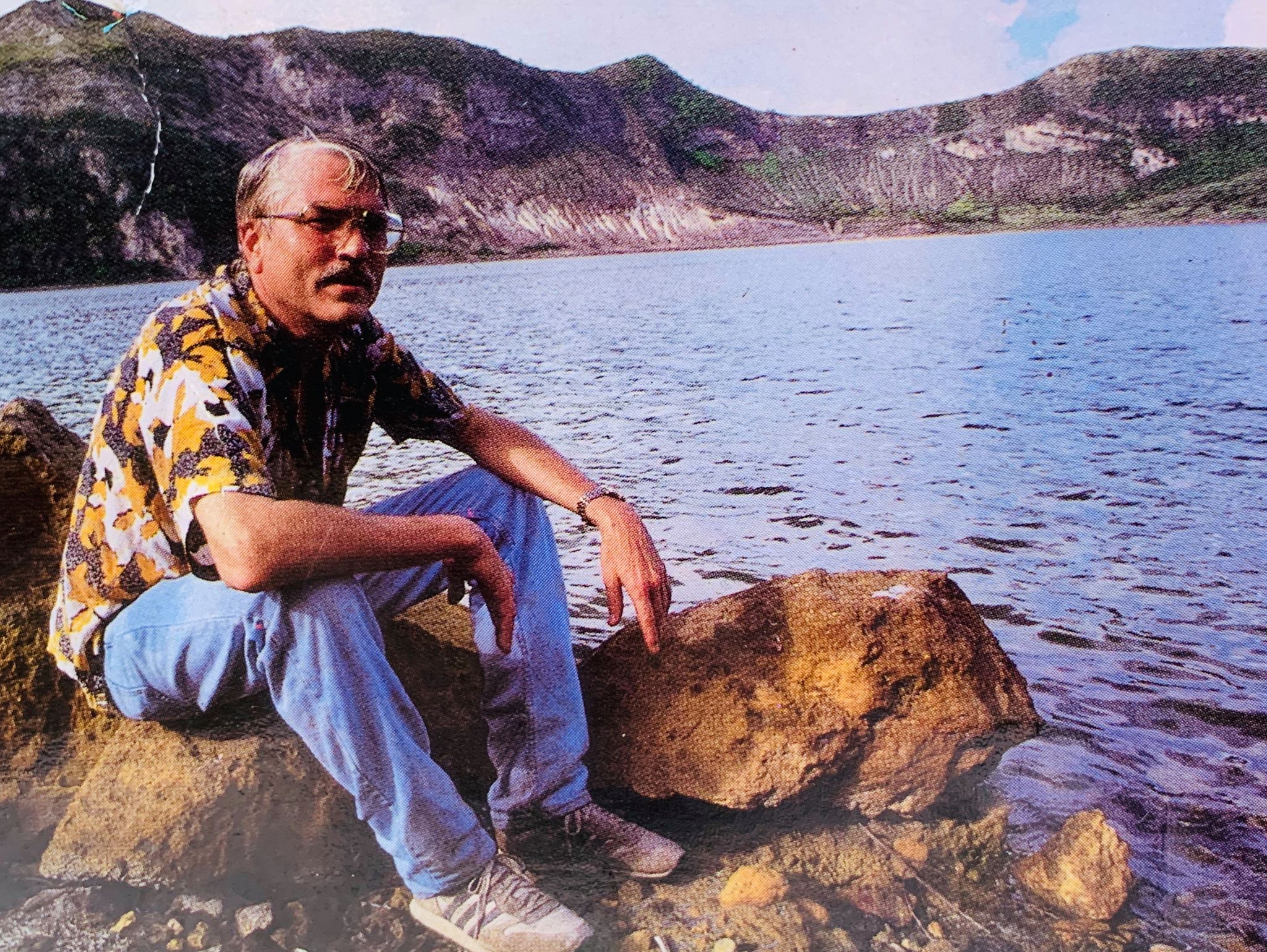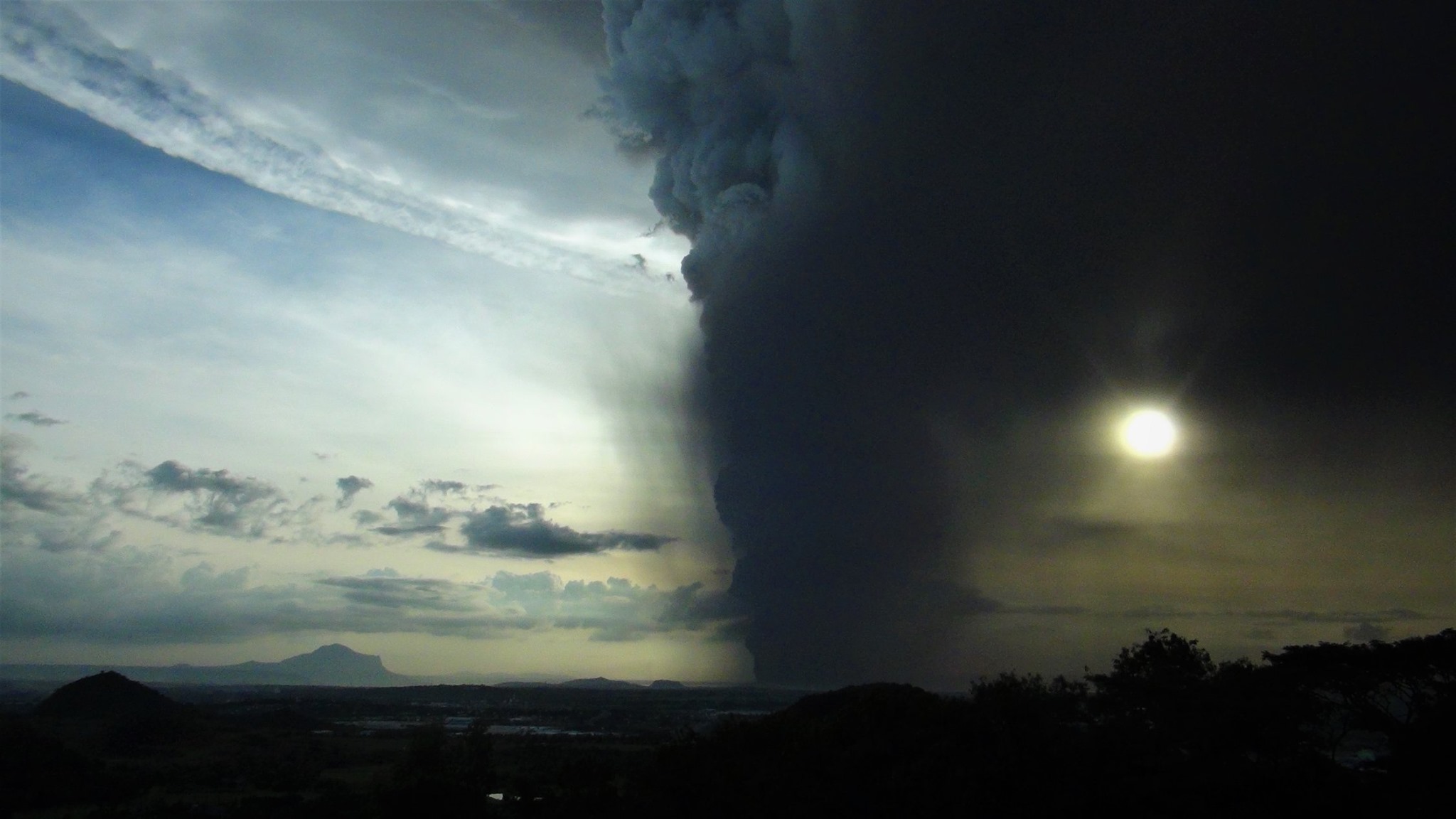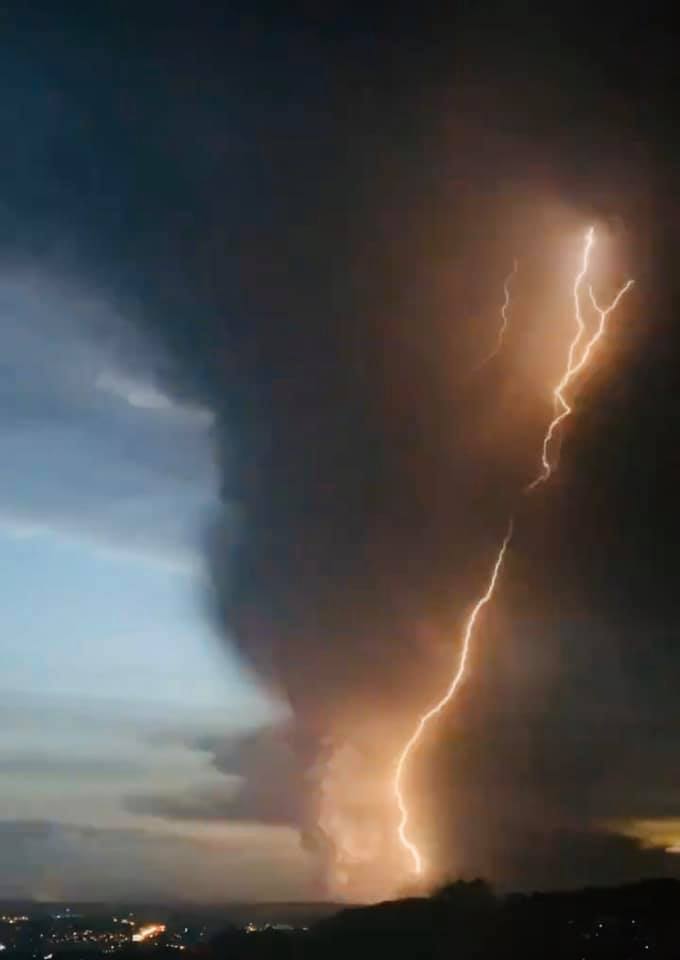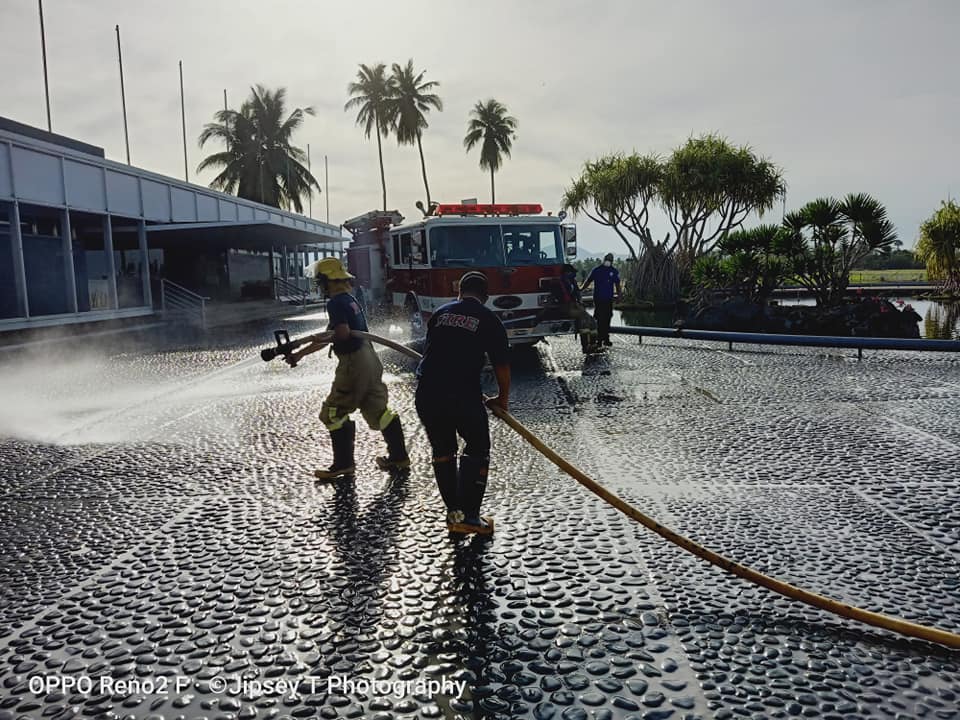Two men, one looking for a fabled gold treasure the other for a Spanish church beneath a forgotten sea, found an epic experience instead.

.
The late Dr. Thomas “Tom” Hargrove, an editor at the International Rice Research Institute (IRRI) and head of IRRI’s Communication and Publications Services (1973-91), was captivated by the history of the Taal Volcano and the lake surrounding it on the Philippine island of Luzon. Tom’s fascination began in 1979 when he first heard about a legend of a Spanish-era church and town that sunk into the lake after one of the volcano’s eruptions from his colleague Urbito “Bito” Ongleo, an IRRI photographer in CPS (1961-89).
Bito, who passed away in September 2008, was an avid treasure hunter. It was during one of his treasure hunts that he heard the tale of the sunken buildings from residents in Lumang Lipa, one of the towns around the lake.
“My grandfather was very addicted to treasure hunting, especially Yamashita’s gold,” recalled Cat Ongleo-Leyno, who cherishes many of his stories to this day. “When he started searching for the gold in Batangas province, he met the family of Natalia who was living in Talisay on the Taal Lake coastline. She told him about the legend of Taal where Taals sits. He couldn’t get the beautiful history of Taal out of his mind and his best decision was when he relayed the story to his good friend Tom; I guess that was the start of their history.”
To research for their expedition, Bito and Tom wrote to the National Archives of Mexico to gather more information about Taal, according to Cat.
“The Spaniards have a lot of stories and documents about Taal that my grandfather got his hands on,” she said. “The most memorable one is about the story of the old sunken town that the Spaniards had burned down and cursed because they couldn’t find their missing cook. This cook was supposed to be at their galleon ship.”
According to the story, which has been told and retold for generations, it was because of the Spanish curse that the old town sank into the lake, then known as Lake Bombon, after an eruption of the volcano most likely in 1754.
An “affair” to remember
Intrigued by the folktale, Tom and his party began their diving expeditions in 1980 in search of the lost church. However, even the local fishermen were unsure about the exact whereabouts of the town. They didn’t find the church during that expedition but Ranjiv Khush, son of then IRRI scientist Dr. Gurdev Khush who joined the team, did find a piece of a broken clay pot that was dated by the National Philippine Museum as a pre-Hispanic artifact from the 15th or 16th century. But its age wasn’t the most interesting thing about the piece of clay pot. Rather, it was covered in crust that was later determined to be corals.
It was because of that artifact that Tom became utterly smitten by Taal, describing it as an “affair” that “has always been murky and passionate, often treacherous, sometimes dangerous but never dull.”
“My dad was passionate about a lot of things, but one of his biggest passions was the Taal Volcano,” Tom’s son, Miles Hargrove, posted on Facebook. “Some of my greatest memories as a kid were the times he took me diving into the surrounding lake’s murky snake-infested waters as we explored the ruins of towns submerged by previous eruptions.
“He even took me diving into the actual volcano crater lake…he claimed that we had to be the first humans to do so. I don’t know if that’s true, but I do know that it was probably one of the scariest (and stupidest) things I’ve done in my life.
“When we finally came back to the surface, my blue swimsuit had turned brown due to sulfuric acid. My mom [Susan] was on a trip to Australia at the time. When she found out my dad had taken her 14-year-old son into the volcano crater she nearly divorced him.”

.
Dangerous dives
Susan wasn’t entirely wrong to be concerned. The dives were not all fun and games as the lake was fraught with real danger.
Gene Hettel, another IRRI communication alumnus (1982-83 and 1995-2016), accompanied Tom and Bito during a couple of their Lake Taal diving trips in 1983.
“I remember how enthusiastic they both were and the sense of excitement that comes with exploring the unknown. It was infectious,’ he said. “But not infectious enough for me to go into the murky waters of that choppy lake, even if I had known how to scuba dive. I was content to help with equipment from the banca and just take in the wonder of it all.”
At 25 kilometers (km) long, 18 km wide, and a shoreline of 115 km, Taal is the third largest lake in the Philippines. Formed in the caldera of a prehistoric eruption, it has an average depth of 100 meters (m) and is 172 m at its deepest point.
“My grandfather said that it is a given that diving in Taal Lake is difficult and unpredictable,” said Cat. “I guess what really amazed me is how he described the depth of Taal. You can’t really tell the topography of this caldera as it has different elevations due to previous eruptions.
You can be treading on a well-leveled ground, find yourself going past seagrasses and see a clean drop of the floor beneath. The next thing you know, you are on an upward slope again. Also, he told us of the hot vents or craters which feel like mines on the seafloor. If you happen to be above one of the vents when it releases steam, you will most likely be critically wounded or dead.”

.
Strange geologic history
“We found Spanish accounts that the lake was previously saltwater,” Tom said in a TV interview. “Starting in 1572, Augustinian priests established the town of Taal on the shore of a great lake of saltwater surrounding a smoking volcano.” Tom described the lake a “biologic enigma” with “an incredible array of marine life that, by laws of nature, has no right to be there.”
“My grandfather told me diving in the lake was difficult because visibility is poor due to plankton and algae,” said Cat. “Just like other locals there, they were also very amazed with its species of fishes and snakes. I remember my mom saw the dive video where they crossed paths with some snakes…I recall my grandfather telling me that some of these species, chances are, can only be found in Taal Lake due to its sulfuric environment and historic setting.”
In his journal article, Sunken Ruins in Lake Taal: An Investigation of a Legend, Tom wrote:
The lake teems with black-and-white banded snakes. I had long suspected they were sea snakes. Like those in the nearby South China Sea, these snakes have small heads, larger bodies, and flat “paddle” tails. Dr. Dioscoro Rabor, a respected biologist at the University of the Philippines at Los Baños, identified it as a sea snake. The Encyclopaedia Britannica (1960) states “only one species, Hydrophis semperi of Lake Taal in Luzon, inhabits freshwater.”
It has been recorded that, of the 47 fish species in the lake, most are marine in origin and several kinds do not occur in the sea. These include the maliputo (Caranx ignobilis), a species of mackerel, and the tawilis (Sardinella tawilis), a species of sardine. Both have adapted to the now freshwater lake. Dr. Rabor also confirmed that sharks (note: probably bull sharks, Carcharhinus leucas, because they can adapt readily to fresh water) once inhabited Lake Taal but they were hunted to extinction by the 1930s.
The aquatic plant species in the lake are also similar to marine plants that can be found in the Mindoro Sea, according to Tom’s research.
“I have a piece of old brain coral, about thirty centimeters in diameter, that we found at a 9-meter depth near the Lipa site,” he said. “Fishermen have shown me other coral gathered in the lake.”
In fact, Taal Lake was once an inlet connected to the West Philippine Sea up until a few centuries ago when tephra (fragmental rocks and ash) produced by the series of eruptions in 1754 and landslides totally blocked the channel leaving only one river, Pansipit, which connects it to the nearby Balayan Bay.
As a result, the inlet became a saltwater lake that was eventually diluted by rainfall over the past 300 years creating a new ecosystem with unique biodiversity.

.
Belligerent goddess of fire and water
As for the submerged settlements of legends, Tom believed that the 6-month-long eruption in 1754, which produced so much ash and smoke that “people in Manila had to carry lanterns in the middle of the day,” wiped out the original towns of Taal, Lipa, Tanauan, and Sala situated on the shore of the lake off the map. With the inlet’s channel totally blocked by volcanic ash and mud, the water in the newly formed lake started to rise and flooded the four towns.
Founded by Augustinian friars in 1572, the inhabitants of the original Taal transferred and sought refuge in the sanctuary of Caysasay to escape from the erupting volcano. There, they established the present-day Municipality of Taal. Lipa, Tanauan, and Sala were likewise relocated. Since the 1754 eruption, other towns have spouted around the lake: Talisay (1869), Cuenca (1877), Alitagtag (1910), Mataasnakahoy (1932), Agoncillo (1949), San Nicolas (1955), Laurel (1961), Santa Teresita (1961), and Balete (1969).
In 1987, Tom and his party discovered structures indicating the possible location of one of the towns that was claimed by the lake. Although, some have suggested these were pre-Spanish settlements or burial ground.
“It is a fascinating story, a dramatic story,” he said during the TV interview after his numerous dives and discoveries. “It’s like detective work or piecing together a jigsaw puzzle.”
“I hope now there is a group of people assigned to dig for historical records regarding Taal,” said Cat. “Its history is ancient, interesting, and worth knowing.”

.
A warning and an homage
The riveting details of Tom and Bito’s Taal explorations are in Tom’s book, The Mysteries of Taal: A Philippine volcano and lake, her sea life and lost towns, where he also made some uncanny prophetic statements:
“But human memory is short. Taal has behaved herself since 1965 (note: the eruption in 1977 was considered a minor steam-driven event), so men now plan to exploit her. They’ll build housing developments along her shores, put golf courses, and Disneyland-type tourist facilities on Tagaytay Ridge, pump water from her fragile ecosystem for irrigation and the sprawling urban centers. Taal will surely strike back, again with anger and vengeance.”
Tom’s book is also his homage to the “world’s angriest volcano” that eventually became his muse:
“She’s like a beautiful and hauntingly mysterious woman… but a jealous and vengeful lady whose wrath makes her all the more sensual. Taal has almost killed me a couple of times… then shared beautiful secrets hidden beneath dark waters. Maybe Lake Taal used me, like she used so many men in her past, to make me write about her.”
Living memories
Tom, who passed away in January 2011, and Bito may be gone but the memories of their adventures live on. Interest in Tom’s book has renewed when the Taal Volcano roared back to life on 12 January. Many articles about the 2020 eruption mention the book. But for members of their family, the two men have created a living legacy that remains vibrant regardless of the volcano’s state.
“I’ll always love him for his sense of adventure, and for sharing that with me,” Miles said about his father.
“Regretfully, my grandfather and Tom are no longer here to share their experiences,” said Cat. “They were the real carriers of the legends. They inspired me to learn diving and take a plunge in the lake’s treacherous waters myself someday. But I guess I will wait when Taal goes back to a peaceful sleep.”






A very interesting article which I use to read from time to time. A legacy of my uncle URBITO TANJUTCO ONGLEO to his Clan.
I knew Taal was as enigmatic as Mayon, Makiling and Banahaw. Thank you for sharing the story of your uncle Bito.
Interesting!
Tom’s book about his experiences in Taal Lake ais available at the following book stores in Manila:National Book Store, Tesoro’s and Silah.
I’ve heard stories about this from Kuya Bito and Sangko Legget (my cousins) but i did not know that it was such a great journey that they were doing. I hope that there are others continuing their expedition. This will make the Philippines on the world map again. Indeed, ours is a great country with many stories and great nature.
Interesting. I will buy a book.